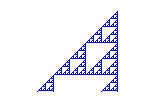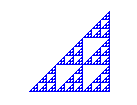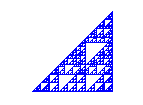Lab 9: Pascal's Triangle (mod 2, 3, 6, and N)
Previously you constructed a triangular grid in which you shaded the entries of Pascal's Triangle that were not divisible by 2. In effect you shaded boxes if they represented odd entries in Pascal's Triangle and you left them unshaded if they represented even entries.
What if you extend that game by first writing the entries of Pascal's Triangle (mod 3)? That is, replace each entry in Pascal's Triangle with its remainder upon division by 3. You will create a triangle whose only entries are "0", "1", and "2". How could you shade those? Try leaving the "0" entries unshaded as you did previously, and shade every box with a "1" or a "2".
Another alternative is to try leaving the "0" entries unshaded and use two colors, red and blue for example, to shade every box with a "1" red and every box with a "2" blue.
Construct 27 rows of Pascal's Triangle (mod 3) in this fashion, with or without colors (your choice), and then do the same construction for 36 rows of Pascal's Triangle (mod 6).
If you compare the constructions for mod 2, mod 3 and mod 6 do you see any relationship? You can make some really interesting patterns by using other numbers for "N".
If you want to look at some constructions with more rows, I have generated images with 216 rows for each construction: mod 2, mod 3, and mod 6


